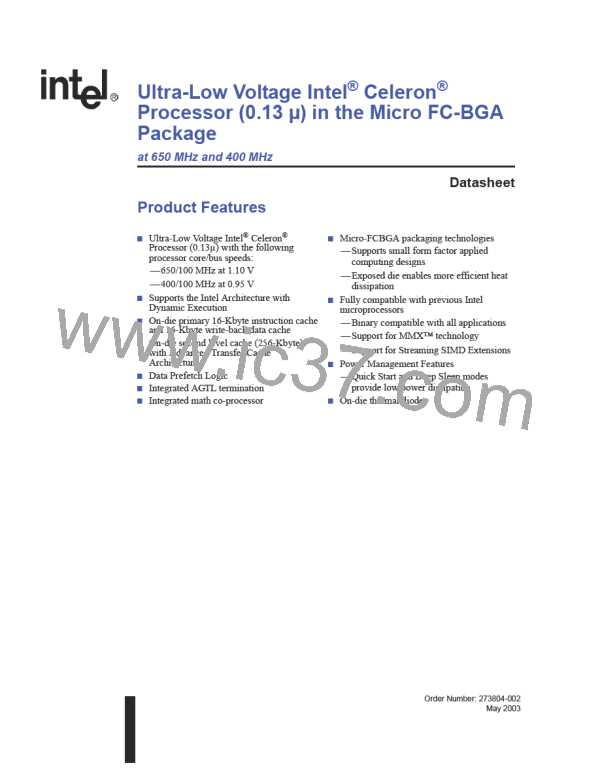Ultra-Low Voltage Intel® Celeron® Processor — 650 MHz and 400 MHz
8.1.32
LOCK# (I/O - AGTL)
The LOCK# (Lock) signal indicates to the system that a sequence of transactions must occur
atomically. This signal must be connected to the appropriate pins/balls on both agents on the
system bus. For a locked sequence of transactions, LOCK# is asserted from the beginning of the
first transaction through the end of the last transaction.
When the priority agent asserts BPRI# to arbitrate for bus ownership, it waits until it observes
LOCK# deasserted. This enables the processor to retain bus ownership throughout the bus locked
operation and ensure the atomicity of lock.
8.1.33
8.1.34
NCTRL (I - Analog)
The NCTRL signal provides the AGTL pull down impedance control. The processor samples this
input to determine the N-channel pull-down device strength when it is the driving agent. An
external 14 Ω (1% tolerance) pull-up resistor to VCCT is required for this signal. Refer to platform
design guide for implementation details.
NMI (I - 1.5 V Tolerant)
The NMI (Non-Maskable Interrupt) indicates that an external interrupt has been generated. NMI
becomes the LINT1 signal when the APIC is disabled. Asserting NMI causes an interrupt with an
internally supplied vector value of two. An external interrupt-acknowledge transaction is not
generated. If NMI is asserted during the execution of an NMI service routine, it remains pending
and is recognized after the IRET is executed by the NMI service routine. At most, one assertion of
NMI is held pending. NMI is rising edge sensitive.
8.1.35
8.1.36
PICCLK (I – 2.0 V Tolerant)
The PICCLK (APIC Clock) signal is an input clock to the processor and system logic or I/O APIC
that is required for operation of the processor, system logic, and I/O APIC components on the
APIC bus.
PICD[1:0] (I/O - 1.5 V Tolerant Open-drain)
The PICD[1:0] (APIC Data) signals are used for bi-directional serial message passing on the APIC
bus. They must be connected to the appropriate pins/balls of all APIC bus agents, including the
processor and the system logic or I/O APIC components. If the PICD0 signal is sampled low on the
active-to-inactive transition of the RESET# signal, then the APIC is hardware disabled. For the
ULV Intel® Celeron® processor, the APIC is required to be hardware enabled as described in
Section 7.1.3.
8.1.37
PLL1, PLL2 (Analog)
The PLL1 and PLL2 signals provide isolated analog decoupling is required for the internal PLL.
See Section 3.2.2 for a description of the analog decoupling circuit.
Datasheet
75

 INTEL [ INTEL ]
INTEL [ INTEL ]